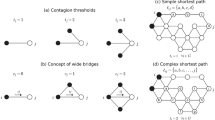Abstract
During the formation process of stochastic networks, nodes tend to establish edges based on selective linkage mechanisms. In general, these mechanisms involve probability distributions that underlie the selection of target nodes. In social networks, edges are often associated to relationships that are homophilic with respect to individual traits. Such traits include, for example, gender and age, and are referred to as node types. Our work considers an affinity-weighted preferential attachment model that characterizes the tendency of two group of nodes to connect to other nodes of the same type. We derive mathematical expressions for the dynamics and convergence of homophily measures at the node, group, and network level. Furthermore, we characterize the convergence of network modularity and show that the formation of community structures can be expressed as a function of network homophily.










Similar content being viewed by others
References
Barabasi, A.L., Albert, R.: Emergence of scaling in random networks. Science 286(5439), 509 (1999)
Jackson, M.O., Rogers, B.W.: Meeting strangers and friends of friends: how random are social networks? Am. Econ. Rev. 97(3), 890 (2007)
Bianconi, G., Barabási, A.L.: Competition and multiscaling in evolving networks. Europhys. Lett. 54(4), 436 (2001)
Dorogovtsev, S.N., Mendes, J.F.F., Samukhin, A.N.: Structure of growing networks with preferential linking. Phys. Rev. Lett. 85(21), 4633 (2000)
Kim, K., Altmann, J.: Effect of homophily on network formation. Commun. Nonlinear Sci. Numer. Simul. 44, 482 (2017)
Bramoullé, Y., Currarini, S., Jackson, M.O., Pin, P., Rogers, B.W.: Homophily and long-run integration in social networks. J. Econ. Theory 147(5), 1754 (2012)
Karimi, F., Génois, M., Wagner, C., Singer, P., Strohmaier, M.: Homophily influences ranking of minorities in social networks. Sci. Rep. 8(11077), 1 (2018)
Lee, E., Karimi, F., Wagner, C., Jo, H.H., Strohmaier, M., Galesic, M.: Homophily and minority-group size explain perception biases in social networks. Nat. Hum. Behav. 3(10), 1078 (2019)
Fernandez, I., Passino, K., Finke, J.: in Proceeding of the Conference on Decision and Control, pp. 0743–1546. Australia, Melbourne (2017)
Growiec, K., Growiec, J., Kamiński, B.: Social network structure and the trade-off between social utility and economic performance. Soc. Netw. 55, 31 (2018)
Pastor-Satorras, R., Vespignani, A.: Epidemic spreading in scale-free networks. Phys. Rev. Lett. 86(14), 3200 (2001)
Liu, Y., Wei, B., Du, Y., Xiao, F., Deng, Y.: Identifying influential spreaders by weight degree centrality in complex networks. Chaos Solitons Fractals 86, 1 (2016)
Wu, Q., Chen, S.: Mean field theory of epidemic spreading with effective contacts on networks. Chao Solitons Fractals 81, 359 (2015)
Price, D.D.S.: A general theory of bibliometric and other cumulative advantage processes. J. Am. Soc. Inf. Sci. 27(5), 292 (1976)
Burt, R.S.: Attachment, decay, and social network. J. Org. Behav. 22(6), 619 (2001)
Krackhardt, D.: The Strength of Strong Ties: The Importance of Philos in Organizations, pp. 216–239. Harvard Business School Press, Boston (1992)
Abbasi, A., Hossain, L., Leydesdorff, L.: Betweenness centrality as a driver of preferential attachment in the evolution of research collaboration networks. J. Informet. 6(3), 403 (2012)
McPherson, M., Smith-Lovin, L., Cook, J.M.: Birds of a feather: homophily in social networks. Annu. Rev. Sociol. 27(1), 415 (2001)
Fortunato, S., Flammini, A., Menczer, F.: Scale-free network growth by ranking. Phys. Rev. Lett. 96(21), 218701 (2006)
Huang, Y., Shen, C., Contractor, N.S.: Distance matters: exploring proximity and homophily in virtual world networks. Decis. Support Syst. 55(4), 969 (2013)
Zadorozhnyi, V., Yudin, E.: Growing network: models following nonlinear preferential attachment rule. Physica A 428, 111 (2015)
Santiago, A., Benito, R.: Evolution of heterogeneous networks under preferential attachment. Int. J. Bifurcation Chaos 20(3), 923 (2010)
Mislove, A., Marcon, M., Gummadi, K.P., Druschel, P., Bhattacharjee, B.: In: Proceedings of the 5th ACM/Usenix Internet Measurement Conference (San Diego, CA, 2007), IMC ’07, pp. 29–42 (2007)
Jadidi, M., Karimi, F., Lietz, H., Wagner, C.: Gender Disparities In Science? Dropout, Productivity, Collaborations And Success Of Male And Female Computer Scientists. Advances in Complex Systems 21(03n04) (2018)
Guerrero, K., Finke, J.: in Proceedings of the Conference on Decision and Control, pp. 2318–2323. Australia, Melbourne (2017)
Currarini, S., Jackson, M.O., Pin, P.: An economic model of friendship: homophily, minorities, and segregation. Econometrica 77(4), 1003 (2009)
Easley, D., Kleinberg, J.: Networks, Crowds, and Markets: Reasoning About a Highly Connected World. Cambridge University Press, New York (2010)
Clauset, A., Newman, M.E., Moore, C.: Finding community structure in very large networks. Phys. Rev. E 70(6), 066111 (2004)
Author information
Authors and Affiliations
Corresponding author
Additional information
Communicated by Pierpaolo Vivo.
Publisher's Note
Springer Nature remains neutral with regard to jurisdictional claims in published maps and institutional affiliations.
Appendix
Appendix
Note that \(\beta _1+\beta _2=2m\). In particular, according to Eq. (8), we know that
where
First, note that \(\alpha _1+\alpha _2=2\). In particular, because \(p_2=1-p_1\), we know that
Similarly, we can show that
and so \(\alpha _1+\alpha _2=2(p_1+p_2)=2\). Second, since \(\alpha _2=2-\alpha _1\), we have
Similarly
So
and thus \(\beta _1+\beta _2=2m(p_1+p_2)=2m\).
Rights and permissions
About this article
Cite this article
Ruiz, D., Campos, J. & Finke, J. Dynamics in Affinity-Weighted Preferential Attachment Networks. J Stat Phys 181, 673–689 (2020). https://doi.org/10.1007/s10955-020-02594-0
Received:
Accepted:
Published:
Issue Date:
DOI: https://doi.org/10.1007/s10955-020-02594-0




